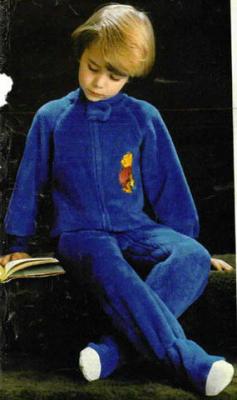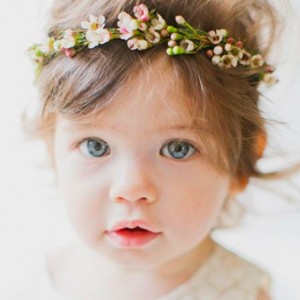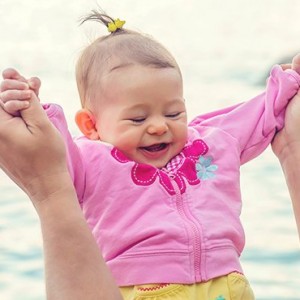When winter storms in, it's your job to make sure your baby stays
warm and dry. But if you're like most new moms, dealing with a squirmy
baby in a bulky jacket, blankets that fall off, and a diaper
bag may sound like a huge hassle. Here are tips and products that make
it easy to keep your baby healthy and comfortable, whether you're going
grocery shopping or tucking your child in for the night.
What helps:
A cozy sleep environment. Choose a warm flannel fitted sheet for your baby's crib (and keep plenty of extras on hand for changes, too). Soft one-piece footed sleepers help your baby stay warm all night by keeping him toasty from head to toe. For an extra layer, put a bodysuit or undershirt underneath the sleeper.
A terrific alternative to a blanket is a sack or wearable blanket that zips up the front and can be worn over a sleeper. These are sleeveless, so your baby can still move his arms around while the rest of his body stays covered.
Tip: You can warm a cold bed with a hot water bottle, a heating pad, or a microwaveable bag. Be sure to remove it before putting your child down to sleep.
What helps:
Easy-on, easy-off outer layers. A snowsuit or bunting provides a great buffer against the cold and snow. Once your baby is dressed in his outfit for the day, you can simply slip him into the snowsuit or bunting just before you head out the door or get out of the car. Snowsuits have form-fitting legs and arms, and most are equipped with hoods, while buntings are more like little sleeping bags, with a seam between the legs to make stroller snap-ins easier. Look for gear with a good layer of insulation and a water-repellent exterior fabric such as fleece, flannel, or fiberfill.
A hat and mittens. A soft hat will help keep out the cold. If your baby's hands are exposed, pull some mittens on them. (If he sucks on his hands, though, keep an extra pair or two handy — once they get wet they'll make him colder rather than warmer.) Make sure your baby has on very warm socks or booties, too.
On frigid days, you can wrap a blanket around the bunting or snowsuit. Don't use a slippery blanket, though, or he may just slide out of your arms. Also handy to have: A stroller blanket, bag, or sack designed to attach to a stroller so it won't slip off.
If you don't want to invest in a bunting or snowsuit, dress your baby in warm, layered clothing, then wrap him in a cotton receiving blanket, and top it off with another, heavier blanket (one made of wool or fleece will work well).
Once you're indoors — even if it's just for a stop at the supermarket — take at least one layer off your baby so he won't perspire. Otherwise, the dampness will make him colder when you get back out in the winter air. And if you've covered your baby with a blanket in the car, you'll want to take it off once the car warms up.
Safety tip: In order to work properly in a crash, car seat straps must be snug — so make sure your baby isn't wearing clothing that's too bulky in the car seat, and don't put blankets between your baby and the straps. Instead, dress him in clothes that allow the straps to go between his legs, adjust the straps to allow for the thickness of his clothes, and pile blankets or other bulky layers on top of the harness straps instead of under them.
Be sensitive to your baby's nonverbal signals. If he's happy to be out at first but starts fussing after a while, he may be trying to tell you that he's cold. It's a good idea to check little fingers, toes, ears, and face regularly, and head inside before he gets uncomfortable.
Safety tip: If your baby's skin seems to be turning white, he's becoming frost-nipped, and you'll want to get indoors right away. Don't try to warm his skin by rubbing it, or you might cause more damage. For the same reason, don't let your baby bear weight on frost-nipped parts — by crawling or walking, for example. Instead, hold his skin against yours (tuck his hands in your armpits, if they're frost nipped). Then immerse the skin in warm (not hot) water. If his skin looks yellowish, stiff, waxy, or significantly swollen, or if it starts blistering, he has frostbite and you'll need to take him to the emergency room right away.
What helps:
Serious outdoor gear. If you plan to take your baby out for winter expeditions regularly, you'll find it worth investing in some serious winter gear. A fuzzy seat liner for the stroller will provide extra bottom warmth, and a baby bunting that fits snugly inside the stroller or jogger will create a cozy cocoon. Look for water-repellent fabrics and a layer of insulation.
Underneath, dress your baby in layers. (A good rule of thumb is that your baby needs one more layer of clothing than you do.) Lycra and silk are better insulators next to the skin than cotton, in part because cotton will stay damp once it absorbs moisture. Of course, you'll want to make sure that your baby's head, neck, hands, and feet are kept well covered.
If you'll be using a stroller, check out the specially made covers to protect your baby from rain, snow, and wind. You can find similar covers for backpacks, and for front packs you can buy a fitted cover (which attaches with Velcro) in warm fleece.
Safety tip: Even the winter sun can damage skin. If your baby is under 6 months old, try to keep his skin out of the sun. Dab a little sunscreen on any parts that might be exposed — like his cheeks — before you head out. The safest sunscreens for babies are chemical-free, and made with zinc oxide or titanium dioxide (these ingredients physically block the sun). If your child's 6 months old or older, apply sunscreen every time you go outdoors. Sunglasses are a good idea, too.
What helps:
Keep your baby's skin moisturized. Many lotions and creams are made especially for babies' sensitive skin. If you're heading outdoors, make it a habit to put on some lotion to prevent dry, chapped skin. (Pediatricians recommend you not put lubricants on a newborn's skin, though — wait until he's a month or so old.) A moisturizing stick that tucks into your diaper bag is handy for on-the-spot TLC.
Soap and water are drying to your baby's skin, so be careful not to overdo the baths in the winter months. When you do wash your baby, use a mild soap and warm, not hot, water. (A thermometer is handy for testing the water temperature.) Don't let him soak in the tub too long. Wrap him in a hooded baby towel as soon as you take him out of the water and pat (don't rub) him dry him quickly. Put a mild baby lotion on his skin, and then bundle him up.
Tip: If the house is very dry, you might consider putting a cool-mist humidifier in the room where your baby sleeps to help keep his nasal passages moist.
 11.06.2015 | 2:44 PM
11.06.2015 | 2:44 PM

 08.14.2013 | 12:45 PM
08.14.2013 | 12:45 PM
 03.19.2013 | 5:50 AM
03.19.2013 | 5:50 AM
 09.08.2012 | 12:41 PM
09.08.2012 | 12:41 PM

 11.04.2008 | 6:41 PM
11.04.2008 | 6:41 PM
 10.18.2008 | 9:27 PM
10.18.2008 | 9:27 PM
 03.13.2007 | 12:00 AM
03.13.2007 | 12:00 AM
How can I keep my baby warm at night without piling on blankets?
You're right not to cover your baby with bedding when you put him to sleep. In fact, to reduce the risk of sudden infant death syndrome (SIDS), experts recommend that you put your baby to sleep on his back without any pillows or coverings at all. They also say it's a good idea not to overheat the room. So keeping your baby warm — but not too warm — can be a little tricky.What helps:
A cozy sleep environment. Choose a warm flannel fitted sheet for your baby's crib (and keep plenty of extras on hand for changes, too). Soft one-piece footed sleepers help your baby stay warm all night by keeping him toasty from head to toe. For an extra layer, put a bodysuit or undershirt underneath the sleeper.
A terrific alternative to a blanket is a sack or wearable blanket that zips up the front and can be worn over a sleeper. These are sleeveless, so your baby can still move his arms around while the rest of his body stays covered.
Tip: You can warm a cold bed with a hot water bottle, a heating pad, or a microwaveable bag. Be sure to remove it before putting your child down to sleep.
What should my baby wear when we leave the house?
There's no way around it — if you're planning to head out the door with your baby in tow on winter mornings, you need an early start. You have a lot to assemble, and your baby may not be the most cooperative once you start putting on that third layer. Here are some things you can use to speed up the process and make it easier for both of you.What helps:
Easy-on, easy-off outer layers. A snowsuit or bunting provides a great buffer against the cold and snow. Once your baby is dressed in his outfit for the day, you can simply slip him into the snowsuit or bunting just before you head out the door or get out of the car. Snowsuits have form-fitting legs and arms, and most are equipped with hoods, while buntings are more like little sleeping bags, with a seam between the legs to make stroller snap-ins easier. Look for gear with a good layer of insulation and a water-repellent exterior fabric such as fleece, flannel, or fiberfill.
A hat and mittens. A soft hat will help keep out the cold. If your baby's hands are exposed, pull some mittens on them. (If he sucks on his hands, though, keep an extra pair or two handy — once they get wet they'll make him colder rather than warmer.) Make sure your baby has on very warm socks or booties, too.
On frigid days, you can wrap a blanket around the bunting or snowsuit. Don't use a slippery blanket, though, or he may just slide out of your arms. Also handy to have: A stroller blanket, bag, or sack designed to attach to a stroller so it won't slip off.
If you don't want to invest in a bunting or snowsuit, dress your baby in warm, layered clothing, then wrap him in a cotton receiving blanket, and top it off with another, heavier blanket (one made of wool or fleece will work well).
Once you're indoors — even if it's just for a stop at the supermarket — take at least one layer off your baby so he won't perspire. Otherwise, the dampness will make him colder when you get back out in the winter air. And if you've covered your baby with a blanket in the car, you'll want to take it off once the car warms up.
Safety tip: In order to work properly in a crash, car seat straps must be snug — so make sure your baby isn't wearing clothing that's too bulky in the car seat, and don't put blankets between your baby and the straps. Instead, dress him in clothes that allow the straps to go between his legs, adjust the straps to allow for the thickness of his clothes, and pile blankets or other bulky layers on top of the harness straps instead of under them.
How long can my baby stay out in the cold?
As long as the weather isn't too unfriendly, it's good for your baby to get some fresh air every day, whether it's in a stroller, carrier, or backpack. Just keep in mind that while you're working up a sweat exercising, your baby is just sitting in the cold — and he'll get chilly well before you do. But how will you know when he's had enough?Be sensitive to your baby's nonverbal signals. If he's happy to be out at first but starts fussing after a while, he may be trying to tell you that he's cold. It's a good idea to check little fingers, toes, ears, and face regularly, and head inside before he gets uncomfortable.
Safety tip: If your baby's skin seems to be turning white, he's becoming frost-nipped, and you'll want to get indoors right away. Don't try to warm his skin by rubbing it, or you might cause more damage. For the same reason, don't let your baby bear weight on frost-nipped parts — by crawling or walking, for example. Instead, hold his skin against yours (tuck his hands in your armpits, if they're frost nipped). Then immerse the skin in warm (not hot) water. If his skin looks yellowish, stiff, waxy, or significantly swollen, or if it starts blistering, he has frostbite and you'll need to take him to the emergency room right away.
What helps:
Serious outdoor gear. If you plan to take your baby out for winter expeditions regularly, you'll find it worth investing in some serious winter gear. A fuzzy seat liner for the stroller will provide extra bottom warmth, and a baby bunting that fits snugly inside the stroller or jogger will create a cozy cocoon. Look for water-repellent fabrics and a layer of insulation.
Underneath, dress your baby in layers. (A good rule of thumb is that your baby needs one more layer of clothing than you do.) Lycra and silk are better insulators next to the skin than cotton, in part because cotton will stay damp once it absorbs moisture. Of course, you'll want to make sure that your baby's head, neck, hands, and feet are kept well covered.
If you'll be using a stroller, check out the specially made covers to protect your baby from rain, snow, and wind. You can find similar covers for backpacks, and for front packs you can buy a fitted cover (which attaches with Velcro) in warm fleece.
Safety tip: Even the winter sun can damage skin. If your baby is under 6 months old, try to keep his skin out of the sun. Dab a little sunscreen on any parts that might be exposed — like his cheeks — before you head out. The safest sunscreens for babies are chemical-free, and made with zinc oxide or titanium dioxide (these ingredients physically block the sun). If your child's 6 months old or older, apply sunscreen every time you go outdoors. Sunglasses are a good idea, too.
How can I keep my baby's skin from getting too dry?
Especially in cold-winter areas, the chill wind outside and dry heat indoors can sap moisture from the hardiest of skins — and your baby's delicate skin is especially vulnerable.What helps:
Keep your baby's skin moisturized. Many lotions and creams are made especially for babies' sensitive skin. If you're heading outdoors, make it a habit to put on some lotion to prevent dry, chapped skin. (Pediatricians recommend you not put lubricants on a newborn's skin, though — wait until he's a month or so old.) A moisturizing stick that tucks into your diaper bag is handy for on-the-spot TLC.
Soap and water are drying to your baby's skin, so be careful not to overdo the baths in the winter months. When you do wash your baby, use a mild soap and warm, not hot, water. (A thermometer is handy for testing the water temperature.) Don't let him soak in the tub too long. Wrap him in a hooded baby towel as soon as you take him out of the water and pat (don't rub) him dry him quickly. Put a mild baby lotion on his skin, and then bundle him up.
Tip: If the house is very dry, you might consider putting a cool-mist humidifier in the room where your baby sleeps to help keep his nasal passages moist.
Member comments
Tripleaaaa
says
We use 7am Enfant blanket212 for
stroller and car seat cover. That way we do not need the layers
underneath and DD is much safer too. They also look awesome!
Report comment
a BabyCenter Member
says
Baby center has been so helpful generally to me............. Maryking
ash138
says
It depends on where you live but if you
are just going from the car into the store you don't need all that extra
layering. It's not like you will be outside for very long. Plus our
group of pediatricians say babies don't need an extra layer. Babies only
need the same number of layers as you wear. Also you can't judge their
temperature by their feet or hands. Those are always going to be cooler
than the core temperature.
a BabyCenter Member
says
I've been using baby undersocks (found
on amazon) to keep my baby's feet and legs warm. Its a nice layering
piece. Undersocks keep socks on, so my son can't wiggle them off, and
the socks are nice and thick. My son seems really comfy in them--the
material is light and soft. They also keep his legs protected and they
come in colors for boys--thank goodness because it seems most footies
and leggings are for girls only. They come in sizes through toddlers.
a BabyCenter Member
says
I bought a JJ Cole Bundle me. Genius! It
is polar fleece with a sherpa-type lining that both lines the infant
seat and covers the infant. Much easier than dressing baby in a
snowsuit, and no extra bulk is added to baby so it's safer. Also there
is no loose blanket to try to keep over baby.
a BabyCenter Member
says
we found a baby sleeping bag called a
Peke Moe, it is made in New Zealand, but what we really liked was that
the babies hands are INSIDE the sleeping bag. We used it to transition
our little girl from her swaddles (which she was addicted to!) but she
transitioned really well into the Peke Moe. There are also other
sleeping bags around too, but none that kept her little hands covered
up. The site is www.pekemoe.co.nz . Hope it is useful for someone else
like it was for us!
NA Cherry
says
The Johnson & Johnson Winter Guide
suggests that silk or Lycra onesies are best for first clothing layer
during winter, but has ANYONE been able to find them? Every onesie I
look at is at least 95% cotton. Help!

















